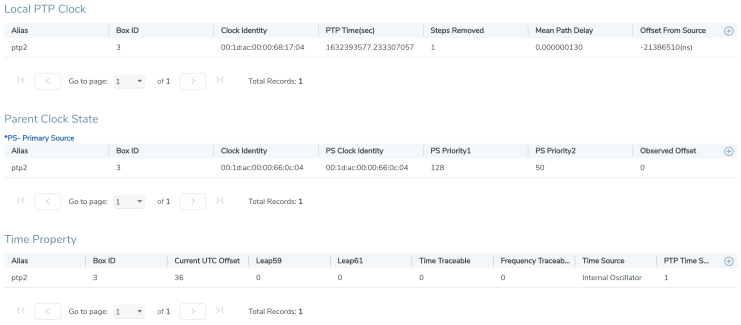Viewing the PTP Clock Details
Use the PTP Clock page to view the local PTP clock, parent clock state, and the time property for the devices for which you have configured PTP. To view this page, go to Settings > Date and Time > PTP Port State. 1 shows the PTP clock details.

| 1 | PTP Clock Details |
Following table lists the PTP clock attributes and their descriptions:
|
PTP Clock Attribute |
Description |
||||||
|
Local PTP Clock |
|||||||
|
Alias |
The unique name for the PTP template that you configured globally for the device. |
||||||
|
Box ID |
The box identifier of the device. |
||||||
|
Clock Identity |
The clock identity of the device. It is a 64-bit global identifier (EUI-64) as defined by the IEEE 1588 standard. |
||||||
|
Ptp Time (sec) |
The actual PTP time with nanosecond resolution. |
||||||
|
Mean Path Delay |
The forward and reverse path delay in steady state is used to calculate the mean path delay. |
||||||
|
Steps Removed |
The number of boundary clocks between the local clock and the foreign source clock. |
||||||
|
Domain |
The network within which PTP operates, that is all the clocks within a domain are in synchronization. |
||||||
|
Offset From Source |
The time difference between the source and the receiver, measured in nanoseconds. Once this is computed, the receiver will readjust its clock to align with the source. |
||||||
|
Priority2 |
The priority value used to determine the primary source in a network. For example, if there are two clocks in a network that match the default criteria, the clock that has the lower priority value will be selected as the primary source. |
||||||
|
Mode |
The clock modes. The values are:
|
||||||
|
Port Ptp Count |
Number of ports on which the PTP template is enabled. Gigamon supports a maximum of 10 boundary clock ports in a device. |
||||||
|
Clock Quality Accuracy |
The clock quality announced by the source. This value is used to select the best clock source between two PTP source clocks and switches dynamically to the clock that has greater accuracy. |
||||||
|
Step Type |
The timestamp mode that is used by PTP. The values is:
|
||||||
|
Local Clock Time |
The actual local clock time on the device. |
||||||
|
Local Priority |
The priority value used to determine the PTP source when the BMC algorithm chooses more than one clock as the source. This value overrides the default criteria for the BMC selection. The clock with the lower priority value will be selected. |
||||||
|
Clock Quality Class |
Attribute of an ordinary or boundary clock that denotes the traceability of the time or frequency distributed by the primary source clock. |
||||||
|
Clock Quality Offset |
The time difference in clock quality between the source and the receiver, measured in nanoseconds. |
||||||
|
Parent Clock State |
|||||||
|
PS Clock Identity |
The clock identity of the primary source. It is a 64-bit global identifier (EUI-64) as defined by the IEEE 1588 standard. |
||||||
|
PS Priority1 |
The priority value of the primary source clock. Lower value takes precedence. |
||||||
|
PS Priority2 |
The priority value of the primary source that is used when PS Priority1 value is the same for different sources in a network. |
||||||
|
Observed Offset |
The time difference that is observed between the source and the receiver. |
||||||
|
Clock Port ID |
The port identifier assigned by the PTP clock. |
||||||
|
Stats |
Indicates whether the values of parentDS.observedParentOffsetScaledLogVariance and parentDS.observedParentClockPhaseChangeRate have been measured and are valid. |
||||||
|
Observed Phase Change Rate |
An estimate of the parent clock's phase change rate as measured by the receiver clock. |
||||||
|
PS Clock Quality Accuracy |
The expected accuracy of the primary source clock. |
||||||
|
PS Clock Quality Class |
The primary source clock’s traceability of the distributed time or frequency. |
||||||
|
PS Clock Quality Offset |
The time difference in clock quality between the primary source and the receiver, measured in nanoseconds. |
||||||
|
Time Property |
|||||||
|
Current UTC Offset |
The time difference between International Atomic Time (TAI) and Universal Coordinated Time (UTC). |
||||||
|
Leap59 |
The last minute of the current UTC day has only 59 seconds (instead of the 60 SI seconds). |
||||||
|
Leap61 |
The last minute of the current UTC day has only 61 seconds (instead of the 60 SI seconds). |
||||||
|
Time Traceable |
The timescale and the UTC offset are traceable to a primary reference. |
||||||
|
Frequency Traceable |
The frequency that determines the timescale is traceable to a primary reference. |
||||||
|
Time Source |
The time source that is external to PTP. The time source is traceable to the international standards laboratories maintaining clocks that form the basis for the TAI and UTC timescales. Examples of these are GPS, NTP, and National Institute of Standards and Technology (NIST) timeservers. |
||||||
|
Ptp Time Scale |
The time scale to use when advertising time for PTP. |
||||||



